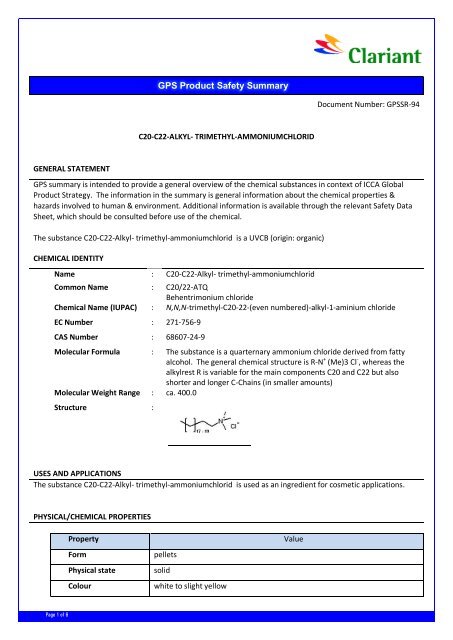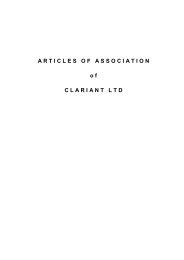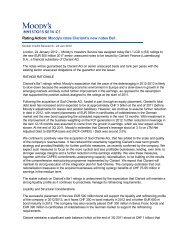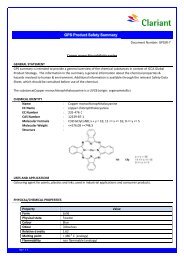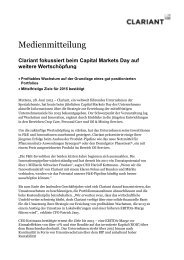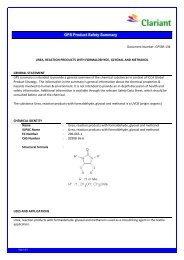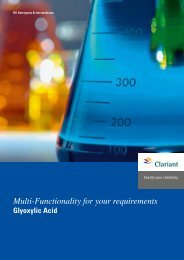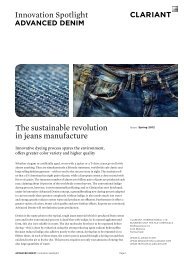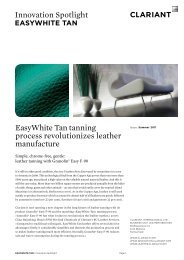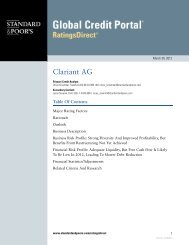gps summary report 94 c20-c22-alkyl- trimethyl - Clariant
gps summary report 94 c20-c22-alkyl- trimethyl - Clariant
gps summary report 94 c20-c22-alkyl- trimethyl - Clariant
You also want an ePaper? Increase the reach of your titles
YUMPU automatically turns print PDFs into web optimized ePapers that Google loves.
GPS Product Safety SummaryDocument Number: GPSSR-<strong>94</strong>C20-C22-ALKYL- TRIMETHYL-AMMONIUMCHLORIDGENERAL STATEMENTGPS <strong>summary</strong> is intended to provide a general overview of the chemical substances in context of ICCA GlobalProduct Strategy. The information in the <strong>summary</strong> is general information about the chemical properties &hazards involved to human & environment. Additional information is available through the relevant Safety DataSheet, which should be consulted before use of the chemical.The substance C20-C22-Alkyl- <strong>trimethyl</strong>-ammoniumchlorid is a UVCB (origin: organic)CHEMICAL IDENTITYName : C20-C22-Alkyl- <strong>trimethyl</strong>-ammoniumchloridCommon Name : C20/22-ATQBehentrimonium chlorideChemical Name (IUPAC) : N,N,N-<strong>trimethyl</strong>-C20-22-(even numbered)-<strong>alkyl</strong>-1-aminium chlorideEC Number : 271-756-9CAS Number : 68607-24-9Molecular Formula : The substance is a quarternary ammonium chloride derived from fattyalcohol. The general chemical structure is R-N + (Me)3 Cl - , whereas the<strong>alkyl</strong>rest R is variable for the main components C20 and C22 but alsoshorter and longer C-Chains (in smaller amounts)Molecular Weight Range : ca. 400.0Structure :USES AND APPLICATIONSThe substance C20-C22-Alkyl- <strong>trimethyl</strong>-ammoniumchlorid is used as an ingredient for cosmetic applications.PHYSICAL/CHEMICAL PROPERTIESPropertyFormPhysical stateColourpelletssolidwhite to slight yellowValuePage 1 of 6
OdourMelting pointExplosive propertiesGPS Product Safety SummaryodourlessIn the range 220 – 240 °C at atmospheric pressurenot explosiveWater solubility 10 mg/L at 25 °COctanol solubilityOctanol-waterpartition coefficient(Log Pow)19.7 g/L3.29 at 20 °CVapour Pressure 7.0× 10 -7 hPa at 20°CRelative density 0.9749 g/cm 3 at 20°CSelf ignitiontemperatureOxidising propertiesFlammability> 400°Cno oxidising propertiesNon-flammableHEALTH EFFECTSHuman Health Safety Assessment:The substance C20-C22-Alkyl- <strong>trimethyl</strong>-ammoniumchlorid is irritating to skin and causes serious eye damage. Itmay cause damage to organs through prolonged or repeated exposure.Consumer : C20-C22-Alkyl- <strong>trimethyl</strong>-ammoniumchlorid is used as an ingredient for cosmetic applications and atcosmetic use concentration, it unlikely to cause irritative effects under their intended use.Worker : C20-C22-Alkyl- <strong>trimethyl</strong>-ammoniumchlorid is used as a raw material in cosmetic formulations. It isproduced in a closed system, dried/palletized and filled into containers. In case of unintended exposure duringmaintenance, sampling, testing, or other procedures workers should follow the recommended safety measuresin the Safety Data Sheet.Effect AssessmentAcute ToxicityOral / inhalation / dermalIrritant effect on skin &eyesSensitisationToxicity after repeatedexposureGenotoxicity /Resultsnot toxic after oral, dermal, inhalation exposureIrritating to skin & eyesnot sensitisingMay cause damage to organs through prolonged or repeatedexposureGenetic toxicity: negativePage 2 of 6
GPS Product Safety SummaryMutagenicityCarcinogenicityToxicity for reproductionNo carcinogenicity to be expectedNo reproductive toxicity to be expectedENVIRONMENTAL EFFECTSEnvironment Safety AssessmentThe substance C20-C22-Alkyl- <strong>trimethyl</strong>-ammoniumchlorid is very toxic to aquatic organisms.C20-C22-Alkyl- <strong>trimethyl</strong>-ammoniumchlorid is evaluated to be not PBT (persistent, bioaccumulative, toxic) orvPvB (very persistent, very bioaccumulative).Effect AssessmentAquatic toxicityVery toxic to Aquatic lifeResultsFate and BehaviourBiodegradationBioaccumulationpotentialPBT / vPvB conclusionReadily biodegradableno bioaccumulation potentialnot PBT or vPvB substancesResultsEXPOSUREC20-C22-Alkyl- <strong>trimethyl</strong>-ammoniumchlorid is produced in a closed system, dried/palletized and filled intocontainers. After transport to the down-stream formulator, C20/22-ATQ is unloaded from the containers intovessels in which it is mixed with other cosmetic raw materials. The concentration of C20/22-ATQ in the finalmixture is
RISK MANAGEMENT RECOMMENDATIONSGPS Product Safety Summaryappropriate risk management measures are in use for manufacturing and downstream use of C20-C22-Alkyl<strong>trimethyl</strong>-ammoniumchloriddescribed in the Chemical Safety Report. These include the use of closedmanufacturing systems, appropriate ventilation systems (as needed), personal protective equipment (asappropriate) and waste treatment options downstreamAlways use appropriate chemical resistant gloves to protect your hands and skin and always wear eye protectionsuch as chemical goggles. Do not eat, drink, or smoke where chemicals are handled, processed, or stored.Remove soiled or soaked clothing immediately. When inhaled remove to fresh air and seek medical aid. Washhands and skin following contact. If the substance gets into your eyes, rinse eyes thoroughly for at least 15minutes with tap water and seek medical attention. Summon a doctor immediately.STATE AGENCY REVIEWThis substance has been registered under REACH.REGULATORY INFORMATION / CLASSIFICATION AND LABELLINGLabelling according CLP regulation (Regulation (EC) No. 1272/2008, as amended):Signal Word:DangerHazard pictogram:GHS05: GHS07: GHS08: GHS09:corrosion exclamation mark health hazard environmentHazard statements:H315: Causes skin irritation. (Irritating to Skin)H318: Causes serious eye damage.H373: May cause damage to organs through prolonged or repeated exposureH400: Very toxic to aquatic life.Precautionary statements:P260: Do not breathe dust/fume/gas/mist/vapours/spray.P264: Wash... thoroughly after handling.P273: Avoid release to the environment.Page 4 of 6
GPS Product Safety SummaryP280: Wear protective gloves/protective clothing/eye protection/face protection.P305+P351+P338: IF IN EYES: Rinse cautiously with water for several minutes. Remove contact lenses, ifpresent and easy to do. Continue rinsing.P337+P313: If eye irritation persists: Get medical advice/attention.CONCLUSIONCONTACT INFORMATION WITHIN COMPANY<strong>Clariant</strong> Produkte (Deutschland) GmbH65926 Frankfurt am MainTelephone no. : +49 69 305 18000GLOSSARYAcute toxicity: harmful effects after a single exposureBiodegradable: breakdown of materials by a physiological environmentBioaccumulation : accumulation of substances in the environmentCarcinogenicity: effects causing cancerChronic toxicity: harmful effects after repeated exposuresClastogen: a substance that causes breaks in chromosomesEmbryotoxicity: harmful effects on foetal healthGHS: Global Harmonized SystemHazard: situation bearing a threat to health and environmentMutagenicity: effects that change genesReprotoxicity: combining teratogenicity, embryotoxicity and harmful effects on fertilitySensitising: allergenicTeratogenic: effects on foetal morphologyDATE OF ISSUEOctober 2011Page 5 of 6
GPS Product Safety SummaryREVISIONADDITIONAL INFORMATIONDISCLAIMERThe information contained in this paper is intended as advice only and whilst the information is provided inutmost good faith and has been based on the best information currently available, is to be relied upon at theuser’s own risk.No representations or warranties are made with regards to its completeness or accuracy and no liability will beaccepted by <strong>Clariant</strong> for damages of any nature whatsoever resulting from the use of or reliance on theinformation.Page 6 of 6


